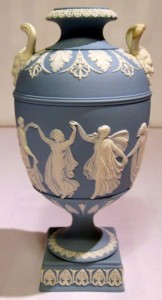14th-century Yuan Dynasty jar tops $1.3M at I.M. Chait March 17 Asia Week sale
March 21st, 2013 by adminBEVERLY HILLS, Calif. – Records were shattered on March 17th at I.M. Chait’s Beverly Hills gallery as the family-owned company known for its expertise in Asian art auctioned the most expensive antique and achieved the highest gross in its 44-year history. The sale of Chinese ceramics and Asian works of art exceeded $3.4 million and was led by a highly important 14th-century Yuan Dynasty porcelain jar that sold for a breathtaking $1,342,000 (inclusive of 22% buyer’s premium). A prominent American collector placed the winning bid over the phone.

Magnificent and highly important 14th-century Yuan Dynasty blue and white ovoid porcelain jar with narrative scene from the Yuan zaju drama ‘The Savior Yuchi Gong.’ Sold for $1,324,000. I.M. Chait image.
I.M. Chait’s director of operations, Josh Chait, described a tense battle that pitted the ultimate winner against an Internet and absentee bidder, as approximately 100 guests in the gallery looked on.
“It was the same feeling as watching a high-stakes gambling event. There’s no way of knowing who will come out on top. Also, whenever there’s a phone or Internet bidder involved, you can never be sure what their limit is,” Chait said.
Beyond the million-dollar threshold, bids on the precious Chinese artifact increased in $10,000 increments. When bidding ceased at $1.1 million, presiding auctioneer and company founder Isadore M. Chait called out, “Going once – going twice – sold!” and brought down the hammer to thunderous applause.
“There was tremendous excitement,” Josh Chait said, describing the scene that followed. “Some 20 people swarmed around the glass display case to take pictures and video the jar for Chinese Facebook and Twitter – and for posterity. Shortly afterward, the Southern California affiliate for NBC called us. It didn’t take long for the story to get out.”
In spectacular condition, the 14-inch blue and white ovoid jar is a revered historical icon from China’s Yuan Dynasty period. Its decorative motif narrates a scene from the Yuan zaju drama “The Savior Yuchi Gong” and describes how General Yuchi Gong saved the Tang Emperor Taizong from assassination. Isadore Chait had correctly predicted the vessel would reach or exceed one million dollars at auction.
Several bronze, jade and furniture lots brought stellar prices, as well. Lot 224, a 7 7/8in spinach jade brushpot with a continuous landscape scene of sages in a courtyard, came to auction with provenance from the Cleveland Museum of Art Collection. Estimated at $35,000-$45,000, it rose to $122,000.
Lot 186, a highly important early 15th-century Ming Dynasty gilt bronze Bodhisattva of Manjushri with six-character Yongle mark under its base finished well within estimate at $274,500. A Sino-Tibetan gilt bronze shrine with jeweled borders and eight elaborately chased repousse Buddhist emblems, entered as Lot 101, was bid to $36,600 against an estimate of $6,500-$8,000. The 295-lot auction’s closer, a pair of Chinese huanghuali wood armchairs, settled at $43,750, more than six times the high estimate.
According to I.M. Chait’s records, most of the bidders taking part in the March 17 auction were either American or Chinese. Some had stopped over in Los Angeles specifically to attend the auction en route to Asia Week New York.
“Holding our annual Asia Week auction at the Beverly Hills gallery was something new for us,” said Isadore Chait. “For the past seven years we had held our sale in Manhattan, and it had developed a strong following with Asia Week’s visitors. Unfortunately, this year we weren’t able to secure a suitable auction space in Manhattan, so we decided to conduct our Asia Week sale right here at our West Coast gallery. Some thought it was a bold move.”
Chait admits that he initially had concerns about the change of venue and feared that not being right in the thick of Asia Week New York might have a negative impact on his company’s March 17 sale.
“In fact, it turned out to be just the opposite. It ended up being the highest-grossing sale in our entire 44-year history,” Chait said. “It’s very encouraging to see that collectors will flock to a sale – no matter where it is held – and spend their hard-earned money if world-class and one of a kind items are offered.”
To contact I.M. Chait Gallery & Auctioneers, call 1-800-775-5020 or 310-285-0182; or e-mail joey@chait.com. Visit the company online at www.chait.com.

